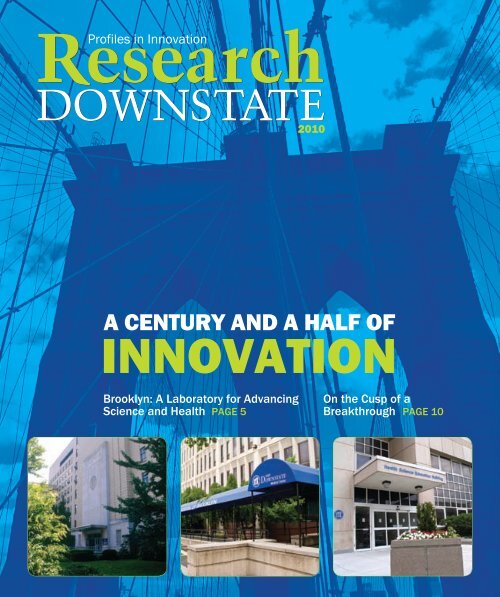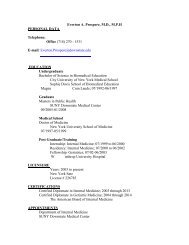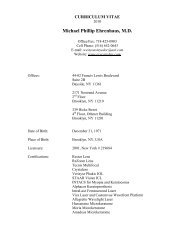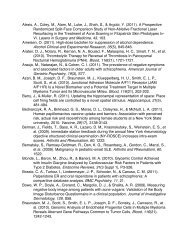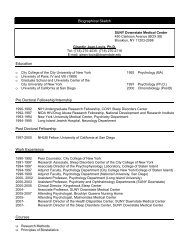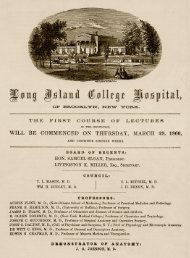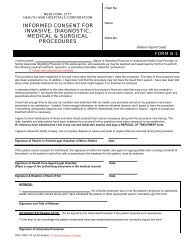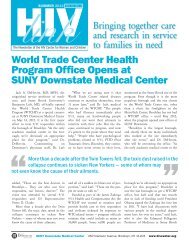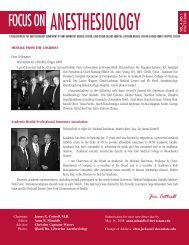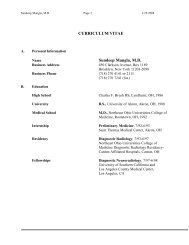Research Downstate 2010 - SUNY Downstate Medical Center
Research Downstate 2010 - SUNY Downstate Medical Center
Research Downstate 2010 - SUNY Downstate Medical Center
Create successful ePaper yourself
Turn your PDF publications into a flip-book with our unique Google optimized e-Paper software.
<strong>Research</strong><br />
Profiles in Innovation<br />
<strong>Downstate</strong><br />
Brooklyn: A Laboratory for Advancing<br />
Science and Health PAge 5<br />
<strong>2010</strong><br />
a Century and a Half of<br />
InnovatIon<br />
On the Cusp of a<br />
Breakthrough PAge 10
MeSSaGe FROM THE DEAN<br />
Throughout <strong>2010</strong>, sUnY <strong>Downstate</strong> is marking its sesquicentennial.<br />
among the many reasons to celebrate this anniversary, one is particularly<br />
salient: for 150 years, sUnY <strong>Downstate</strong> faculty members have<br />
engaged in basic, translational, and clinical research with the goal of<br />
alleviating suffering and restoring health.<br />
some of these investigations have directly transformed medicine, while others<br />
produced insights into human physiology and pathology that opened new avenues<br />
of research that years later resulted in new ways of preventing or treating illnesses.<br />
this issue of Profi les in Innovation features an article highlighting some of the<br />
most important scientifi c and medical advances made by sUnY <strong>Downstate</strong> faculty<br />
over the 150 years. these medical milestones span a range of health problems, from<br />
heart disease and kidney failure to Marfan’s syndrome and low self-esteem.<br />
not unexpectedly, many of these advances have changed more than one fi eld of<br />
medicine. Dr. Robert Furchgott’s nobel Prize-winning discovery of nitric oxide’s role<br />
in the body is the basis for fi nding new ways to treat heart disease, dementia, cancer,<br />
lung disease, infl ammatory joint disease, and other medical problems that affect,<br />
literally, hundreds of millions of people worldwide.<br />
today, sUnY <strong>Downstate</strong> basic scientists, behavioral scientists, clinicians, and<br />
public health experts are expanding our knowledge of a broad range of healthcare<br />
topics. In this issue, you can read about bench research being conducted to understand<br />
how brain cells communicate; fi nd ways to boost HDL, or “good,” cholesterol;<br />
create a mouse model to study the effects of maternal crack bingeing on babies; and<br />
elucidate the genetic mechanism by which sleep disturbances increase the risk of<br />
cardiovascular disease.<br />
You can also read about research aimed at translating scientifi c discoveries into<br />
new medical interventions. <strong>Downstate</strong> researchers are harnessing the power of computing<br />
and their knowledge of the brain to create a prosthetic hand that works like<br />
the real one and testing the blood of heart surgery patients for an antibody that they<br />
suspect causes a damaging infl ammatory response after surgery.<br />
working in Brooklyn, members of the <strong>Downstate</strong> community are keenly aware of<br />
the health problems of inner-city residents. two new research projects—one examining<br />
the reasons for the overuse of emergency room care, the other exploring the causes<br />
of health disparities among residents of the borough—are highlighted in this edition<br />
of Profi les in Innovation. By fi nding solutions to these problems, <strong>Downstate</strong> can<br />
contribute to solving important challenges confronting our nation.<br />
In another way, <strong>Downstate</strong> is already taking lessons learned in Brooklyn and<br />
using them to help people elsewhere. Brooklyn’s diversity is key to the success of<br />
<strong>Downstate</strong>’s International emergency <strong>Medical</strong> Program, which trains emergency<br />
medicine residents to work in other countries and to provide humanitarian relief.<br />
In this issue, you can also learn about the sUnY eye Institute, whose goal is to<br />
advance basic, translational, and clinical research in the fi eld by creating a collaborative<br />
research program among three sUnY campuses--<strong>Downstate</strong>, Upstate, and<br />
the state College of optometry. and, fi nally, on its tenth anniversary, you can read<br />
about the remarkable success of <strong>Downstate</strong>’s Biotech Park as a scientifi c enterprise,<br />
economic engine, and workforce development initiative.<br />
Ian Taylor, MD, PhD<br />
senior Vice President,<br />
Biomedical education and <strong>Research</strong><br />
Dean, College of Medicine
<strong>Research</strong><br />
Profiles in Innovation<br />
<strong>Downstate</strong><br />
Contents<br />
02 A Century and a Half of<br />
Innovation<br />
Brooklyn: A Laboratory for<br />
Advancing Science and Health<br />
05 Eva Cramer, PhD<br />
A Biotech Park Grows in Brooklyn<br />
05 William Brunken, PhD, Douglas Lazzaro, MD<br />
A New Prescription for Eye <strong>Research</strong>: Collaboration<br />
06 Christina Bloem, MD, MPH<br />
Around-the-World Emergency Care<br />
07 Clinton Brown, MD, Ruth Browne, ScD, MPH<br />
Same Borough, but Worlds Apart: <strong>Research</strong> into<br />
Inequities in Brooklyn Healthcare<br />
08 Grace Wong, MBA, MPH<br />
Partners in Care: The Problem of Acute Care<br />
Overuse Meets Its Match<br />
President<br />
John C. LaRosa, MD<br />
<strong>Research</strong><br />
Ian Taylor, MD, PhD<br />
Senior Vice President,<br />
Biomedical Education and <strong>Research</strong><br />
Dean, College of Medicine<br />
Mark Stewart, MD, PhD<br />
Dean, School of Graduate Studies<br />
Vice Dean for <strong>Research</strong><br />
Administration<br />
Ivan Lisnitzer<br />
Executive Vice President and<br />
Chief Operating Officer<br />
Debra D. Carey, MS<br />
Chief Executive Officer,<br />
University Hospital of Brooklyn<br />
JoAnn Bradley, EdD<br />
Senior Vice President,<br />
Institutional Advancement and<br />
Philanthropy<br />
<strong>2010</strong><br />
On the Cusp of a Breakthrough<br />
10 Diana Dow-Edwards, PhD<br />
Teasing Influences Apart: A New Model for In-Utero<br />
Crack Exposure<br />
11 Joseph T. Francis, PhD<br />
The Repair Man: Brain-Machine Interfaces and the<br />
Quest for a New Kind of Prosthesis<br />
12 Mahmood Hussain, PhD<br />
Midnight Oil: Sleep Disturbances’ Impact on<br />
Lipoprotein Production<br />
13 Henri Tiedge, PhD<br />
Travel to the Junction: RNA’s Journey from Nucleus<br />
to Synapse<br />
14 Ming Zhang, MD, PhD<br />
Once Around the Block: Decoding the Causes of<br />
Ischemic Injury<br />
16 Weijun Jin, MD<br />
More for the Good: Exploring the HDL Cholesterol<br />
Pathway<br />
<strong>Downstate</strong> ReseaRch:<br />
PRofiles in innovation<br />
is published by the Office of<br />
Institutional Advancement<br />
and Philanthropy.<br />
Scientific Editor Mark Stewart, MD, PhD<br />
Managing Editor Ina Lancman, MS<br />
Editor Brian Kell<br />
Writer Elizabeth Galst<br />
Advisers John M. Allen, Ross Clinchy, PhD<br />
Design Bruce Kuo<br />
Photography Ernest Cuni<br />
All rights reserved. Address correspondence to Office of Institutional Advancement and Philanthropy, <strong>SUNY</strong> <strong>Downstate</strong> <strong>Medical</strong> <strong>Center</strong>, 450 Clarkson Avenue, Box 93, Brooklyn, NY 11203.
02 DOWNSTATE RESEARCH <strong>2010</strong><br />
A Century and a Half of Innovation<br />
A Century and a Half of Innovation<br />
the Collegiate Division of the<br />
Long Island College Hospital<br />
(LICH), the predecessor to<br />
today’s sUnY <strong>Downstate</strong> <strong>Medical</strong><br />
<strong>Center</strong>, was launched on March 29,<br />
1860, in the City of Brooklyn at a time<br />
when formal medical education was still<br />
largely theoretical and lecture-based.<br />
LICH’s founding proved to be a seminal<br />
event in U.s. medical history. the<br />
college, one of 47 medical schools in<br />
the country at the time (there are now<br />
132), was the first in the country to integrate<br />
direct patient care with lectures<br />
and classroom study. “the Long Island<br />
College Hospital,” wrote the Brooklyn<br />
eagle newspaper the day after LICH’s<br />
opening, “starts with means which will<br />
enable them not only to succor the<br />
afflicted, but to establish a College for<br />
instruction, the benefits of which will be<br />
experienced over the whole country, and<br />
reflect distinction on the city in which it<br />
is located.”<br />
that article was prescient. since the<br />
medical school’s beginnings in Brooklyn<br />
Heights in the spring of 1860, its faculty<br />
has contributed to the transformation<br />
of medical practice around the world.<br />
among its researchers and clinicians<br />
are a nobel Prize winner, the developer<br />
of a revolutionary imaging technology,<br />
a pioneer in the use of the heart-lung<br />
machine, and the inventor of a kind of<br />
microsurgery that has allowed for corneal<br />
transplants, to name just a few.<br />
<strong>Downstate</strong>’s tradition of medical<br />
innovation goes back to its very beginnings,<br />
with LICH faculty member<br />
Austin Flint, sr., MD. “austin Flint’s<br />
name is forever attached to a heart murmur,”<br />
the so-called Flint murmur, says<br />
Jason Lazar, MD, director of <strong>Downstate</strong>’s<br />
cardiovascular training program. “But<br />
austin Flint had considerably greater<br />
achievements.”<br />
at a time when infectious diseases<br />
claimed thousands of lives and epidemics<br />
were common, the widely published and<br />
respected Dr. Flint was an early advocate<br />
of germ theory, the idea that microorganisms<br />
spread many forms of infectious<br />
disease. “In an era when surgeons were<br />
still performing operations bare-handed,<br />
he was a tireless proponent of hand washing,”<br />
Dr. Lazar notes. still, Dr. Flint’s biggest<br />
innovation was his popularization of<br />
the stethoscope and the listening to heart<br />
and lung sounds for diagnostic purposes.<br />
“Because of Flint’s influence,” Dr. Lazar<br />
says, “the stethoscope became an important<br />
tool in medical practice and remains<br />
one to this day.”<br />
among the next generation of innovators<br />
at the medical college was its own<br />
1863 alumnus Alexander skene, MD,<br />
LLD. a leader in american gynecology,<br />
he wrote a textbook, Treatise on the<br />
Diseases of Women, that was described<br />
in 1894 as the “best work ever written”<br />
Among <strong>Downstate</strong>’s researchers and clinicians are a<br />
Nobel Prize winner, the developer of a revolutionary<br />
imaging technology, a pioneer in the use of the heart-lung<br />
machine, and the inventor of a kind of microsurgery that<br />
has allowed for corneal transplants, to name just a few.<br />
in the field. Dr. skene was the first to<br />
identify the para-urethral glands, later<br />
renamed the skene glands. He also<br />
developed a number of innovative surgical<br />
techniques. “He was able to provide<br />
women with great relief,” notes Kathleen<br />
e. Powderly, CnM, PhD, an expert on<br />
Dr. skene’s career and the acting director<br />
of <strong>Downstate</strong>’s Division of Humanities<br />
in Medicine. so great was Dr. skene’s<br />
impact that a bust was erected in his<br />
honor at Brooklyn’s Grand army Plaza.<br />
as the decades progressed, researchers<br />
at LICH continued to provide leadership<br />
in american medicine. Jean<br />
Redman oliver, MD, a kidney specialist<br />
who chaired the Department of<br />
Pathology from 1929 until 1954, revolutionized<br />
the understanding of human<br />
kidney function using a technique<br />
known as microdissection. “Before<br />
oliver, no one had been able to explain<br />
how kidney nephrons” — kidneys’ functional<br />
units — “relate to kidney functions<br />
and disease,” says nephrologist<br />
Garabed eknoyan, MD, co-founder of<br />
the International association for the<br />
History of nephrology and a professor of<br />
medicine at Baylor College of Medicine.<br />
“Dr. oliver’s research underpins much<br />
of what we know about kidney function<br />
today.”<br />
Dr. oliver’s contemporary at LICH,<br />
Alfred Adler, MD, had a similar impact<br />
on the field of psychology. an austrianborn<br />
contemporary of Freud, Dr. adler<br />
served at LICH from 1932 until his<br />
death in 1937. Dr. adler, who coined<br />
the term “inferiority complex,” believed<br />
mental health professionals could effect<br />
positive changes by focusing on patients’<br />
strengths, says Richard watts, PhD, an<br />
adler scholar at sam Houston state<br />
University. “at a time when psychology<br />
focused on what was wrong with<br />
people,” says Dr. watts, “he was a proponent<br />
of an optimistic and positive psychology<br />
that has had a profound impact<br />
on current clinical practice.”<br />
the post-world war II era brought<br />
with it a period of tremendous growth<br />
in the medical school and in its research<br />
capacity. In 1950, the College, which<br />
had, by then, separated from LICH,<br />
merged with the newly established<br />
state University of new York to form<br />
the sUnY <strong>Downstate</strong> <strong>Medical</strong> <strong>Center</strong>.<br />
such was the importance of expanding<br />
The writer is indebted to Kathleen Powderly, CNM, PhD, acting director of <strong>Downstate</strong>’s Division of Humanities in Medicine, for her original research on <strong>Downstate</strong>’s history and for her assistance<br />
with this article.<br />
Dr. Powderly and Jack Termine, former DMC archivist, John Zubrovich and Aaron Cormier of Biomedical Communications have compiled a lively online timeline of <strong>Downstate</strong>’s 150-year<br />
history. It can be viewed at www.downstate.edu/sesquicentennial/index.html
the capacity of Brooklyn’s only academic<br />
medical center that in october 1954<br />
President Dwight David eisenhower laid<br />
the cornerstone for the Basic sciences<br />
Building on Clarkson avenue.<br />
Chandler McCuskey Brooks, PhD,<br />
chaired the Department of Physiology<br />
then. a renaissance man with interests<br />
in theology and philosophy, he made<br />
significant contributions to the study<br />
of cardiac and neuronal electrophysiology,<br />
neuroendocrinology, and the autonomic<br />
nervous system. Dr. Brooks was<br />
also the first dean of <strong>Downstate</strong>’s school<br />
of Graduate studies, which opened in<br />
1966. His experiments uncovered how<br />
changes in the heart’s electrical activity<br />
can lead to fatal arrhythmias. and<br />
his research laid the groundwork for the<br />
development of the cardiac pacemaker.<br />
“He was a physiologist of the body, not<br />
of a cell, an enzyme, or a molecule,”<br />
write his collaborators Kiyomi Koizumi,<br />
MD, PhD, and Mario Vassalle, MD, in<br />
a memorial essay. “He was a true physiologist<br />
who wanted to understand the<br />
secret mechanisms of the extraordinary<br />
human machine.”<br />
Dr. Brooks’s contemporary evelyn<br />
Witkin, PhD, who worked at <strong>Downstate</strong><br />
from 1955 until 1971, “was a transformative<br />
figure in science,” says Graham<br />
walker, PhD, the american Cancer<br />
society <strong>Research</strong> Professor at MIt. she<br />
studied the cellular responses to Dna<br />
damage. the human body undergoes<br />
tens of thousands of genetic insults daily,<br />
and such injury can result in health<br />
problems that include cancer, neurological<br />
disorders, immunological illnesses,<br />
and accelerated aging.<br />
Dr. witkin was one of the first<br />
women elected to the national academy<br />
of sciences. Dr. witkin established that<br />
cells can become resistant to radiation,<br />
and, working alone in her lab, later went<br />
on to identify proteins that can repair<br />
Dna damage. says Dr. walker, “evelyn<br />
witkin played a key, early role in helping<br />
us understand that cellular responses to<br />
Dna damage have enormous implications<br />
for human health.”<br />
the record of innovation at sUnY<br />
<strong>Downstate</strong> during this period attracted<br />
Clarence Dennis, MD, a pioneer in the<br />
development of the heart-lung machine.<br />
Austin Flint, Sr., MD<br />
Alfred Adler, MD<br />
Beginning in the late 1930s, while at the<br />
University of Minnesota, Dr. Dennis<br />
and his colleagues had begun designing<br />
a machine that could perform the<br />
functions of the heart and the lungs,<br />
thereby making open-heart surgery possible.<br />
In 1951, Dr. Dennis performed<br />
the world’s first open-heart operation.<br />
though the machine worked perfectly,<br />
the patient did not survive, due to the<br />
complexity of his condition. In 1955,<br />
after moving to <strong>Downstate</strong>, Dr. Dennis<br />
again performed open-heart surgery<br />
using a heart-lung machine, and this<br />
time the patient survived. It was the<br />
world’s second successful operation<br />
using a heart-lung machine. “Creating<br />
a machine that could substitute for the<br />
heart and the lungs was a technical tour<br />
de force,” says Jeffrey Borer, MD, chair of<br />
the Department of Medicine and chief of<br />
cardiovascular medicine at <strong>Downstate</strong>.<br />
Dr. Dennis’s contributions to the field,<br />
Dr. Borer says, “made possible a type<br />
Alexander Skene, MD, LLD Jean Redman Oliver, MD<br />
Chandler McCuskey Brooks, PhD Evelyn Witkin, PhD<br />
of cardiac repair that was previously<br />
unimaginable.”<br />
the 1950s, ‘60s, and ‘70s were<br />
the period in which ophthalmologist<br />
Richard C. troutman, MD, spearheaded<br />
the development of sophisticated<br />
ophthalmic instruments and complex<br />
surgical techniques that are still in use<br />
today. among them: corneal transplants,<br />
intraocular lens implantation, in which<br />
an eye’s clouded lens is replaced by a<br />
clear plastic one, and refractive surgery<br />
for improved eyesight. these accomplishments<br />
are all the more remarkable<br />
given that Dr. troutman began his work<br />
during an era when eye surgery was<br />
still performed without magnification.<br />
Collaborating with microscope manufacturers,<br />
he developed the first high-precision<br />
microscopes for surgical use, thereby<br />
founding the field of ophthalmic microsurgery.<br />
“He gave ophthalmology the<br />
push it needed to enter the modern era,”<br />
says Douglas Lazzaro, MD, professor<br />
<strong>2010</strong> DOWNSTATE RESEARCH<br />
03
04 DOWNSTATE RESEARCH <strong>2010</strong><br />
A Century and a Half of Innovation<br />
and chair of <strong>Downstate</strong>’s Department<br />
of ophthalmology. “Conditions that previously<br />
led to blindness for millions of<br />
people are now treatable, thanks to Dr.<br />
troutman’s ingenuity and perseverance.”<br />
In the 1970s, eli Friedman, MD, who<br />
in 1964 founded the first federally funded<br />
dialysis clinic, went on to invent the portable<br />
hemodialysis machine. He accomplished<br />
this only 14 years after the first<br />
patient with chronic kidney failure began<br />
ongoing dialysis treatment. Inspired<br />
by the fact that short-term dialysis had<br />
been performed on wounded soldiers<br />
with acute kidney failure on the Korean<br />
war battlefield, Dr. Friedman designed<br />
the attaché case-sized machine to make<br />
the treatment available to patients who<br />
needed to travel far from the country’s<br />
few dialysis centers. the device also<br />
spawned home dialysis, which remains<br />
popular among rural patients for whom<br />
commuting to far-off treatment centers<br />
Clarence Dennis, MD<br />
Raymond Damadian, MD<br />
would be impossible. says Dr. Friedman,<br />
“our machine validated the idea that kidney<br />
failure doesn’t equal death.”<br />
In the 1970s, Raymond Damadian,<br />
MD, performed his early work on magnetic<br />
resonance imaging (MRI) and<br />
developed at <strong>Downstate</strong> the world’s first<br />
whole-body MRI scanner. the technology<br />
uses magnetic fields and radio frequencies<br />
to visualize body tissue. It is hard<br />
to overstate how profoundly MRI technology<br />
has “revolutionized diagnostic<br />
imaging,” says MRI expert Bill Bradley,<br />
MD, PhD, chair of the Department of<br />
Radiology at the University of California,<br />
san Diego. In fact, a 2001 survey of top<br />
internists ranked MRI as one of the two<br />
most important medical innovations of<br />
the previous 25 years. “Dr. Damadian<br />
thought MRI technology would be useful<br />
in tumor detection,” says Dr. Bradley. “It<br />
turns out, it’s useful for detecting a wide<br />
range of diseases and conditions that had<br />
Richard C. Troutman, MD Eli Friedman, MD<br />
Robert Furchgott, PhD Brendan Lee, MD, PhD<br />
no effective diagnostic methods before<br />
MRI was developed.”<br />
the 1998 nobel Prize winner<br />
Robert Furchgott, PhD, chair of the<br />
Department of Pharmacology from<br />
1956 to 1988, had a similarly profound<br />
impact on the world of cardiology. In<br />
1980, Dr. Furchgott discovered that a<br />
then-unidentified “endothelium-derived<br />
relaxing factor” allows for the relaxation<br />
of the muscle cells in blood vessels’<br />
walls, and plays a crucial role in the<br />
regulation of blood pressure. In 1986,<br />
Dr. Furchgott established that eDRF<br />
was the gas nitric oxide. the nitric oxide<br />
pathway is now being explored as a treatment<br />
for a host of illnesses, including<br />
heart disease and pulmonary hypertension.<br />
“the discovery of nitric oxide and<br />
its function,” said Dr. Valentin Fuster,<br />
then president of the american Heart<br />
association, in a 1998 interview, “is one<br />
of the most important in the history of<br />
cardiovascular medicine.”<br />
In the late 1980s, a post-doctoral student<br />
at <strong>Downstate</strong>, Brendan Lee, MD,<br />
PhD, was part of a team of researchers<br />
who discovered the genetic mutation<br />
that causes Marfan syndrome, a sometimes<br />
fatal disease of the body’s connective<br />
tissue. Dr. Lee was also the first to<br />
clone the gene — an incredible technical<br />
achievement at that time. that cloning<br />
confirmed the link between the genetic<br />
mutation and Marfan syndrome. “these<br />
discoveries were major breakthroughs for<br />
the entire field of connective tissue disease,”<br />
says Josephine Grima, PhD, the<br />
national Marfan Foundation’s vice president<br />
of research and legislative affairs.<br />
a century and a half after its beginnings<br />
at LICH, sUnY <strong>Downstate</strong> continues<br />
this tradition of innovation. In<br />
fields as diverse as HIV and diabetic retinopathy,<br />
the brain’s extracellular matrix<br />
and angiogenesis, among many others,<br />
its faculty makes discoveries and invents<br />
devices that change the way medicine<br />
is practiced. since 2006, many of these<br />
world-changing researchers have been<br />
featured in this annual publication. Like<br />
their predecessors, <strong>Downstate</strong>’s current<br />
faculty offer “succor to the afflicted,” and<br />
their research generates benefits that will<br />
be experienced, in years to come, across<br />
the country and around the world.
A Biotech Park Grows in Brooklyn<br />
Despite its wealth of scientific and<br />
biomedical talent, new York<br />
City has long lagged behind<br />
areas like Boston and san Francisco in<br />
attracting and retaining small and midsized<br />
biotechnology companies.<br />
the reason is simple, says eva<br />
Cramer, PhD, <strong>Downstate</strong>’s vice president<br />
of biotechnology and scientific<br />
affairs and a distinguished service professor<br />
of cell biology. “there’s a lack of<br />
affordable lab space.”<br />
envisioning a solution that could<br />
benefit emerging biotech firms, and<br />
<strong>Downstate</strong> and new York City scientists<br />
as well, Dr. Cramer and colleagues<br />
devised in 2000 a plan for a biotechnology<br />
incubator, a lab facility that provides<br />
already-built bench and office space<br />
at reasonable prices. “we started with<br />
no real estate, no money, just the idea<br />
that we could capitalize on the synergy<br />
between companies and our faculty and<br />
students,” Dr. Cramer recalls.<br />
that idea has grown into a<br />
Biotechnology Park adjacent to the campus,<br />
a larger facility on the Brooklyn<br />
waterfront called BioBat, plus an educational<br />
program that prepares college<br />
science majors for jobs in biotechnology.<br />
the Biotechnology Park, featured<br />
in a March <strong>2010</strong> article in Crain’s new<br />
York Business, is one of only two biotech<br />
incubators in the whole of new York<br />
City. It includes the 24,000-square-foot<br />
advanced Biotechnology Incubator and a<br />
state-of-the-art synthetic chemistry facility.<br />
the proximity of both helps facilitate<br />
interactions between the companies<br />
and <strong>Downstate</strong>’s faculty and students.<br />
BioBat, a 486,000 square-foot facility for<br />
more mature biotech companies, is based<br />
at the former Brooklyn army terminal.<br />
tenants include the International aIDs<br />
Vaccine Initiative, a developer of HIV<br />
vaccines; BioCangen, which designs<br />
assays for cancer detection; and Biosignal<br />
Group, a producer of devices that<br />
record brainwaves. “Having these different<br />
kinds of spaces means we can provide<br />
smaller companies with larger facilities<br />
as they grow,” Dr.Cramer says.<br />
Because “science courses do not adequately<br />
equip science majors for employment<br />
in biotech labs,” Dr. Cramer says,<br />
the incubator’s one-month workforce<br />
development component teaches undergraduate<br />
students biotech job skills.<br />
to date, the program has helped more<br />
than 90 students find work in the field.<br />
“these students are well received by a<br />
wide range of employers, from the City’s<br />
<strong>Medical</strong> examiner’s office and the new<br />
York Blood <strong>Center</strong>, to the american<br />
Museum of natural History,” Dr.<br />
Cramer says. a number of graduates are<br />
employed at the incubator itself.<br />
“Faculty members now have a place<br />
to pursue their entrepreneurial projects<br />
right next to the school,” Dr. Cramer<br />
says. “our medical and graduate students<br />
can experience the excitement of<br />
working at biotech start-ups. and the<br />
dream we had ten years ago has been<br />
built, and continues to grow, right here<br />
in Brooklyn.”<br />
A New Prescription for Eye <strong>Research</strong>:<br />
Collaboration<br />
more faculty, there’s<br />
more collaboration, and<br />
“With<br />
more possibilities.” so<br />
says william Brunken, PhD, professor<br />
of cell biology and ophthalmology<br />
about the recently launched sUnY eye<br />
Institute. Dr. Brunken co-directs the<br />
eye Institute with John Hoepner, MD,<br />
chair of ophthalmology at the Upstate<br />
<strong>Medical</strong> University in syracuse, and<br />
David troilo, PhD, vice-president of<br />
sUnY state College of optometry.<br />
the program is a collaboration among<br />
Brooklyn: A Laboratory for Advancing Science and Health<br />
Eva Cramer, PhD<br />
the faculty of these schools<br />
as well as faculty from stony<br />
Brook University’s school of<br />
Medicine and the University at<br />
Buffalo school of Medicine &<br />
Biomedical sciences. through<br />
the sharing of resources and<br />
intellectual capital, the eye<br />
Institute is poised to turn new<br />
York’s state University system<br />
into one of the nation’s powerhouses<br />
in basic, translational,<br />
and clinical vision research.<br />
William Brunken, PhD Douglas Lazzaro, MD<br />
<strong>2010</strong> DOWNSTATE RESEARCH<br />
05
06 DOWNSTATE RESEARCH <strong>2010</strong><br />
Brooklyn: A Laboratory for Advancing Science and Health<br />
the eye Institute’s most important<br />
achievement to date is the creation<br />
of a mechanism for collaboration and<br />
communication where none existed<br />
before. “In the past, a lot of our vision<br />
researchers worked in their own silos,”<br />
explains Douglas Lazzaro, MD, chairman<br />
of <strong>Downstate</strong>’s Department of<br />
ophthalmology. “now, using our listserv<br />
and our web site”— sunyeye.org — “we’ll<br />
be able to communicate much more efficiently<br />
with our colleagues about the scientific<br />
questions we’re pursuing and the<br />
resources we have to offer each other.”<br />
one of these resources is the patient<br />
population that receives care at sUnYaffiliated<br />
hospitals. “Collectively, that’s<br />
not long after Haiti’s devastating<br />
earthquake this<br />
winter, ten <strong>Downstate</strong> medical<br />
faculty, residents, and nurses<br />
were on the ground at the University<br />
Hospital in Port-au-Prince, providing<br />
around-the-clock emergency room<br />
care. “the hospital was having trouble<br />
getting 24-hour staffing in the eR, and<br />
we were willing and available to do<br />
that,” explains Christina Bloem, MD,<br />
MPH, clinical assistant professor of<br />
emergency medicine.<br />
the group’s effort was an example<br />
of the medical school’s International<br />
emergency <strong>Medical</strong> Program in action.<br />
“shortly before the earthquake, we had<br />
begun collaborating with a clinic in the<br />
town of terrier Rouge, in northern Haiti,<br />
helping them build capacity,” says Dr.<br />
Bloem, the program’s director. “and this<br />
work became part of what I hope will<br />
be multi-year project now.” In fact, the<br />
group returned to Haiti in april.<br />
International emergency medicine is<br />
the newest subspecialty in <strong>Downstate</strong>’s<br />
nationally renowned emergency Medicine<br />
Department established in 2006,<br />
the International emergency Medicine<br />
Program trains residents in what Dr.<br />
Bloem identifies as the two branches of<br />
international emergency medicine: “one<br />
is humanitarian relief, disaster relief.<br />
the other is more academic, developing<br />
between 250,000 and 300,000 patients,”<br />
Dr. Brunken explains. “with the appropriate<br />
ethical guidelines in place, this<br />
offers a powerful tool for research<br />
that cuts across a wide demographic<br />
spectrum.”<br />
the eye Institute’s investigators<br />
also hope that their new collaboration<br />
will attract to the field of vision research<br />
investigators in related disciplines such<br />
as biochemistry, material science, and<br />
epidemiology. “the problems we’re<br />
looking at — diseases of the retina and<br />
neurodegeneration — are big problems,”<br />
Dr. Brunken says. “they’ll benefit from<br />
the involvement of researchers with<br />
other areas of expertise.”<br />
emergency medicine as a specialty in<br />
other countries.”<br />
In fact, emergency care like that provided<br />
in the United states is scarce in<br />
most parts of the world. “a lot of places<br />
don’t have pre-hospital systems. they<br />
don’t have ambulances,” Dr. Bloem<br />
notes. In many countries, physicians<br />
who staff eRs have none of the specialized<br />
training in trauma and other<br />
emergent conditions that emergency<br />
medicine doctors in developed nations<br />
have. “one of the things we teach our<br />
residents is how to share their medical<br />
expertise and their knowledge about<br />
structuring emergency medical systems,”<br />
Dr. Bloem says.<br />
already, the establishment of the<br />
eye Institute helped attract nationally<br />
renowned glaucoma researcher John<br />
Danias, MD, PhD, to <strong>Downstate</strong>. “I was<br />
excited with the prospect of working with<br />
a number of diverse investigators and<br />
expanding my clinical and translational<br />
research,” Dr. Danias says. “<strong>Downstate</strong><br />
provided those opportunities and the<br />
eye Institute expanded them further.”<br />
the eye Institute also represents a<br />
model for similar research programs in<br />
the large sUnY system. Plans for collaboration<br />
and cooperation, such as those<br />
at the foundation of the eye Institute,<br />
are at the heart of Chancellor nancy<br />
Zimpher’s new vision for sUnY.<br />
Around-the-World Emergency Care<br />
IEM members (from left): Ernest Garnier, MD, clinical assistant professor; Debra Barrow, RN; Robert<br />
Gore, MD, clinical assistant professor; Dr. Christina Bloem; Marie France Senat-Zephir, RN.<br />
to date, the emergency Medicine<br />
Department’s faculty and residents<br />
have established collaborations with<br />
medical facilities in Jamaica, turkey,<br />
south africa, Romania, Lesotho, India,<br />
and Brazil, as well as in Haiti. “when<br />
we were there,” says Dr. Bloem of the<br />
department’s relief work this winter, “we<br />
were able to utilize the many skills we<br />
have learned in central Brooklyn: handling<br />
large volumes of patients, working<br />
with diverse populations.”<br />
“at <strong>Downstate</strong>,” she adds, “you learn<br />
to be open to other cultures and other<br />
methods of healthcare delivery. that<br />
serves us well, in Brooklyn and in our<br />
international endeavors.”
a joke among people<br />
whose primary lan-<br />
“there’s<br />
guage isn’t english,” says<br />
Humberto Brown, Ma, director of health<br />
disparities/new constituency development<br />
for the arthur ashe Institute<br />
for Urban Health (aaIUH). “If you<br />
tell a medical provider you’re not good<br />
at english,” Mr. Brown quips, “he or<br />
she will speak very loudly, as if<br />
the volume will solve the communication<br />
problem.”<br />
the ashe Institute, which has an<br />
office on the <strong>Downstate</strong> campus, works<br />
closely with faculty and staff on programs<br />
dedicated to improving the wellbeing<br />
of vulnerable urban populations.<br />
a study the Institute conducted found<br />
many older Latinos didn’t access healthcare<br />
that was available to them because<br />
“their issues were talked about at a volume<br />
that allowed everybody to hear.”<br />
this finding and Mr. Brown’s anecdote<br />
illustrate one reason why health<br />
disparities exist in the United states<br />
and in Brooklyn in particular. a recent<br />
survey by the Robert wood Johnson<br />
Foundation found that Brooklyn ranked<br />
58th out of 62 new York state counties in<br />
terms of health outcomes. Residents of<br />
new York City’s poorest neighborhoods,<br />
including many who live in the areas<br />
surrounding <strong>Downstate</strong>, have life expectancies<br />
four years shorter than those in<br />
the city’s most affluent districts. “In<br />
50%<br />
25%<br />
0%<br />
12%<br />
Same Borough, but Worlds Apart<br />
<strong>Research</strong> into Inequities in Brooklyn Healthcare<br />
23%<br />
11%<br />
25%<br />
17%<br />
Brooklyn, we see severe disparities in the<br />
areas of cardiovascular disease, infant<br />
mortality, HIV and aIDs, asthma, and<br />
other chronic health conditions,” notes<br />
Brooklyn’s Deputy Borough President<br />
Yvonne J. Graham.<br />
to help understand the causes of<br />
these disparities and to provide solutions,<br />
<strong>Downstate</strong>, the arthur ashe Institute,<br />
and the Borough President’s office leveraged<br />
their long-term relationships to<br />
establish, in 2004, the Brooklyn Health<br />
Disparities <strong>Center</strong> (BHDC). “the BHDC<br />
is the place that brings together researchers<br />
and advocates who work both within<br />
the University and outside of it to pursue<br />
Hispanics Who Speak Spanish as Primary Language Have More<br />
Problems Communicating with Their Physicians<br />
Doctor listened to<br />
some or only a<br />
little<br />
Patient<br />
understood some<br />
or only a little<br />
24%<br />
Hispanic–English at home ■ Hispanic–Spanish at home<br />
Members of the Brooklyn Health Disparities <strong>Center</strong> (from left): Humberto Brown; Dr. Clinton Brown;<br />
Dr. Tracey Wilson; Kweli Henry; Dr. Marilyn Fraser White; Girardin Jean-Louis, PhD, co-director,<br />
<strong>Research</strong> Core, associate professor of medicine; Dr. Ruth Browne; and Ferdinand Zizi, MBA, clinical<br />
instructor of health sciences.<br />
Had question,<br />
didn’t ask<br />
26%<br />
43%<br />
One or more<br />
problems with<br />
communication<br />
common goals,” says <strong>Center</strong> Director<br />
Clinton Brown, MD, an associate professor<br />
of clinical medicine at <strong>Downstate</strong>.<br />
since the <strong>Center</strong>’s founding, its<br />
faculty has trained <strong>Downstate</strong> cardiovascular<br />
fellows in health disparities<br />
research. It established the summer<br />
Institute Program to Increase Diversity<br />
in Cardiovascular Health Disparities<br />
<strong>Research</strong>, which instructs junior scientists<br />
from around the country in those<br />
same research issues. It developed innovative<br />
curricula to train hair stylists to<br />
become lay health advocates who can<br />
teach their customers about cardiovascular<br />
health and disease, and it has built<br />
Deaths Due to Diabetes: Racial/Ethnic Disparities<br />
are Widening<br />
Deaths per 100,000 adults<br />
60<br />
50<br />
40<br />
30<br />
20<br />
10<br />
Race/ethnicity<br />
White<br />
Black<br />
Hispanic<br />
0<br />
1990–1992<br />
Rates are age-adjusted.<br />
1993–1995 1996–1998 1999–2001<br />
Sources: Bureau of Vital Statistics, NYC DOHMH; U.S. Census 1990 and 2000/NYC Department of City Planning<br />
<strong>2010</strong> DOWNSTATE RESEARCH<br />
07
08 DOWNSTATE RESEARCH <strong>2010</strong><br />
Brooklyn: A Laboratory for Advancing Science and Health<br />
a strong network of community-based<br />
organizations that advises the <strong>Center</strong> on<br />
community health issues.<br />
now, with funding from the nIH’s<br />
national <strong>Center</strong> on Minority Health<br />
and Health Disparities (nCMHHD),<br />
“the BHDC is laying the groundwork for<br />
future research and policy recommendations<br />
to combat health disparities,”<br />
says tracey wilson, PhD, the <strong>Center</strong>’s<br />
research core co-director and associate<br />
professor of community health sciences.<br />
to achieve these ends, the Health<br />
Disparities <strong>Center</strong> is enhancing its<br />
already existing relationships. “this is<br />
really a capacity-building grant,” explains<br />
ashe Institute Ceo Ruth Browne, scD,<br />
MPH, who is also co-director of the<br />
<strong>Center</strong>. the <strong>Center</strong> is now designing a<br />
curriculum on health disparities research<br />
for high school students who participate<br />
in the Institute’s Health sciences<br />
academy. “the academy is a program<br />
we run here on the <strong>Downstate</strong> campus,”<br />
Dr. Browne explains, “where faculty and<br />
graduate students teach talented minority<br />
students in a three-year, after-school<br />
science enrichment program, coupled<br />
Residents of northern and central<br />
Brooklyn suffer from startlingly<br />
high rates of infant mortality,<br />
HIV/aIDs, cardiovascular disease,<br />
and other illnesses. they also overutilize<br />
high-cost emergency room (eR) and<br />
inpatient care. one measure of this overutilization<br />
is highlighted by this fact: the<br />
eR at University Hospital of Brooklyn<br />
(UHB), <strong>Downstate</strong>’s teaching hospital,<br />
was designed, in 2001, to treat as many<br />
as 25,000 patients annually but in 2009<br />
saw 73,000.<br />
what is the connection between<br />
these two phenomena?<br />
Grace wong, MBa, MPH, <strong>Downstate</strong>’s<br />
vice-president for managed care and clinical<br />
business, has decided to find out.<br />
she is motivated by a belief that<br />
Brooklyn’s healthcare resources can<br />
be employed in ways that can improve<br />
A Tale of Two Neighborhoods: Access to Healthcare in Brooklyn<br />
Percent of adults not receiving needed medical care in the past year:<br />
Central Brooklyn (Bedford-Stuyvesant, Crown Heights) 14%<br />
Northwest Brooklyn (Brooklyn Heights, Park Slope) 5%<br />
Percents are age-adjusted.<br />
Source: NYC Community Health Survey, 2002<br />
with an urban public health program.”<br />
the nCMHHD funding will also enable<br />
the <strong>Center</strong> to place these students in<br />
paid summer internships at local community-based<br />
organizations “to conduct<br />
surveys and needs assessments and to<br />
disseminate information,” she adds. also<br />
strengthened by this grant is the BHDC’s<br />
involvement with community-based<br />
organizations, such as the Caribbean<br />
women’s Health association, the arabamerican<br />
Family support <strong>Center</strong>, and<br />
the Haitian <strong>Center</strong>s Council. “these<br />
groups really have their fingers on the<br />
pulse of their communities,” explains<br />
Marilyn Fraser white, MD, the BHDC’s<br />
co-director of community engagement<br />
and the aaIUH’s associate director of<br />
research and training.<br />
Partners in Care:<br />
Acute Care Overuse Meets Its Match<br />
residents’ health while keeping medical<br />
costs down. and her ambitious Brooklyn<br />
Healthcare Improvement Project (BHIP),<br />
supported by a new York Healthcare<br />
efficiency and affordability Law grant, is<br />
designed to make that happen. the project<br />
will, first, investigate the factors that<br />
impact health and healthcare provision<br />
in its 15 zip-code, mid-Brooklyn study<br />
area. then, employing a unique public/<br />
private/community partnership, it will<br />
develop recommendations and solutions<br />
that can benefit residents, healthcare<br />
providers, and insurers alike.<br />
In this endeavor, Ms. wong is joined<br />
by two groups: an advisory panel made<br />
up of community leaders, government<br />
representatives, health insurers, and<br />
business owners; and a team of<br />
academics. Her colleagues include<br />
Jeanne stellman, PhD, a professor<br />
the <strong>Center</strong> staff has begun training<br />
40 such organizations in communitybased<br />
participatory research, in which<br />
members of the communities affected<br />
by conditions or issues under study act<br />
as full participants in the research process.<br />
“we believe that this community<br />
involvement is key to identifying reasons<br />
for health disparities,” Dr. white says.<br />
to further its policy-change goals,<br />
the <strong>Center</strong> is “teaching communitybased<br />
organizations how to make recommendations<br />
to legislators and other<br />
policy makers,” says BHDC policy analyst<br />
Kweli Henry, MPH.<br />
all of these efforts can lead to the<br />
elimination of the health disparities that<br />
prevent many in Brooklyn from living<br />
long and healthy lives.<br />
of environmental and occupational<br />
health sciences in the Department<br />
of Preventive Medicine; Michael<br />
Lucchesi, MD, chair of the Department<br />
of emergency Medicine and medical<br />
director at University Hospital of<br />
Brooklyn; Howard s. Berliner, scD, professor<br />
and chair of the Department of<br />
Health Policy and Management at the<br />
school of Public Health; Dorothy Fyfe,<br />
MPa, assistant vice-president for planning;<br />
and Michael Gusmano, PhD, of<br />
the Hastings Institute.<br />
“we hope,” says Dr. stellman, “that<br />
our unique stakeholder collaboration<br />
can continue, in order to address the<br />
many pressing healthcare needs in our<br />
community.”<br />
one of the project’s most powerful<br />
tools is GIs technology. Geographic<br />
information systems technology
captures, analyzes, and presents location-related<br />
data. BHIP will use it to<br />
create a sophisticated, block-by-block<br />
map that “will help us identify the factors<br />
that impact health among the study<br />
area’s one million residents,” Ms. wong<br />
says. the map will also help assess<br />
the state of healthcare provision in the<br />
study area. Included will be healthcare<br />
providers’ hours of operation, languages<br />
spoken, and types of medical care offered.<br />
that information will be integrated with<br />
data on “health status, health service<br />
utilization, socio-economic, and housing<br />
indicators, as well as a variety of other<br />
variables affecting the community’s<br />
well-being,” Ms. wong says.<br />
though the project is in its initial<br />
stages, its researchers have already identified<br />
many of the causes of acute care<br />
overutilization: Patients frequently come<br />
to the eR for non-emergencies because<br />
“there is a shortage of primary care in<br />
the area,” Ms. wong says. In fact, 14 of<br />
the 15 zip codes under study have been<br />
deemed medically underserved areas by<br />
the federal government. Patients who do<br />
have primary care providers often don’t<br />
have access to them during evenings<br />
or on weekends. other neighborhoodspecific<br />
issues include substance abuse,<br />
mental illness, and patients’ inability<br />
to afford medication. Difficulty in navigating<br />
the fractured healthcare system<br />
plays a role as well: “often, patients feel<br />
their medical issues can be dealt with<br />
more quickly by going to the eR than by<br />
being ping-ponged among specialists,”<br />
Ms. wong explains.<br />
Rate of Ambulatory Care Sensitive Admissions per 100,000<br />
Hospital Admissions, 2002<br />
Blacks are two to four times more likely than whites and Hispanics to be<br />
hospitalized for potentially preventable conditions<br />
From left: Dorothy Fyfe; Dr. Jeanne Stellman; Priya Pasram, MPH, project coordinator; and Grace<br />
Wong with the map of Brooklyn ER visits.<br />
after the BHIP has collected and<br />
analyzed all of its data, the project<br />
leaders will meet with organizations,<br />
including the Brooklyn Chamber of<br />
Commerce, the healthcare workers’<br />
union 1199seIU, eight health insurers,<br />
six hospitals, community groups, senior<br />
centers, and the Brooklyn Borough<br />
President’s office, to formulate solutions<br />
to the area’s healthcare problems.<br />
“we envision new incentives for<br />
healthcare providers to make primary<br />
and specialty care more available in the<br />
neighborhoods under study,” Ms. wong<br />
notes. Unnecessary use of acute care can<br />
also be reduced, she believes, by the creation<br />
of multispecialty ambulatory care<br />
centers that allow patients to have their<br />
complex medical problems addressed at<br />
one facility, rather than having to shuttle<br />
among medical offices. Insurers might<br />
well realize a financial benefit from paying<br />
doctors extra to see patients on weekends<br />
or evenings, so that they don’t incur<br />
the cost of expensive eR visits. the proper<br />
use of resources would improve the<br />
healthcare that area residents receive,<br />
and by extension, their health.<br />
BHIP’s findings and recommendations<br />
may have much wider applications<br />
as well. one private insurer told<br />
Ms. wong, “Your borough’s the toughest<br />
healthcare area in the country. If you can<br />
fix Brooklyn, you can fix the nation.”<br />
Grace wong, for her part, sees that<br />
the possibilities abound.<br />
Emergency Department Visits Without Admission, 2006-2008<br />
United Hospital Fund Neighborhood Rate of ED visits without Median household<br />
United Hospital Fund Neighborhood Rate of admission ED visits without per 100 Median household income<br />
Greenpoint<br />
Greenpoint<br />
admission residents per 100<br />
residents 2006 - 2008<br />
2006 - 2008<br />
33<br />
33<br />
income 2000<br />
2000<br />
$ 27,205<br />
$ 27,205<br />
Williamsburg-Bushwick<br />
Williamsburg-Bushwick<br />
43<br />
43<br />
$ 21,160<br />
$ 21,160<br />
Brooklyn Brooklyn Heights-Park Heights-Park Slope Slope 26 26 $ 48,476<br />
$ 48,476<br />
Bedford Stuyvesant-Crown Heights Heights 43 43 $ 26,514 $ 26,514<br />
East New York 48 48 $ 25,574 $ 25,574<br />
Sunset Park 37 37 $ 29,754 $ 29,754<br />
Borough Park 17 17<br />
$ 31,781 $ 31,781<br />
East Flatbush-Flatbush 33<br />
33<br />
$ 34,194<br />
$ 34,194<br />
Canarsie-Flatlands<br />
Canarsie-Flatlands<br />
30<br />
30<br />
$ 44,113<br />
$ 44,113<br />
Bensonhurst-Bay Ridge<br />
Bensonhurst-Bay Ridge<br />
22<br />
22<br />
$ 40,307<br />
$ 40,307<br />
Coney Island-Sheepshead Bay<br />
Coney Island-Sheepshead Bay<br />
27<br />
27<br />
$ 31,375<br />
$ 31,375<br />
Source: Michael K. Gusmano and Daniel Weisz. <strong>2010</strong>. “Assessing Access to Primary Care in Brooklyn,” April 22, <strong>2010</strong>.<br />
Source: Original Michael analysis K. of Statewide Gusmano Planning and Daniel and Weisz. <strong>Research</strong> <strong>2010</strong>. Cooperative “Assessing System Access (SPARCS) to Primary data Care by authors. in Brooklyn,” April 22, <strong>2010</strong>.<br />
Original analysis of Statewide Planning and <strong>Research</strong> Cooperative System (SPARCS) data by authors.<br />
<strong>2010</strong> DOWNSTATE RESEARCH<br />
09
10 DOWNSTATE RESEARCH <strong>2010</strong><br />
On the Cusp of a Breakthrough<br />
one doesn’t hear much about<br />
the crack-cocaine epidemic<br />
these days. the news articles<br />
about crack-exposed newborns, so common<br />
at the epidemic’s outset in the mid-<br />
1980s, have disappeared from the front<br />
pages of the nation’s newspapers. and<br />
the epidemic itself peaked in 1990.<br />
nevertheless, every year in the United<br />
states, an estimated 165,000 women<br />
smoke crack while pregnant, according<br />
to the federal substance abuse and<br />
Mental Health services administration.<br />
In the last decade, more than a million<br />
crack-exposed babies have been born.<br />
Clinicians have studied the development<br />
of children exposed in utero<br />
to this purified, smoke-able form of<br />
cocaine since the epidemic began. they<br />
have documented problems with behavior<br />
and attention, deficits in language<br />
and cognition, lower academic achievement,<br />
and lower IQs. neuroimaging has<br />
revealed anatomical differences in brain<br />
development between crack-exposed and<br />
otherwise healthy children. But, because<br />
many children exposed to crack in utero<br />
are raised in homes with drug-using and/<br />
or mentally unstable parents, separating<br />
the impacts of prenatal crack cocaine<br />
exposure from other influences on brain<br />
development, behavior, and cognitive<br />
function is difficult.<br />
studies with animal models can help<br />
answer questions about crack’s impact<br />
on exposed offspring. But to date, the<br />
only models available to researchers<br />
conducting studies in pregnant rats and<br />
their progeny have been ones that mimic<br />
maternal nasal cocaine use rather than<br />
crack bingeing, which gives users a faster<br />
and more intense “high.”<br />
Diana Dow-edwards, PhD, is attempting<br />
to rectify that problem. a professor of<br />
physiology and pharmacology and of cell<br />
biology, Dr. Dow-edwards is using funding<br />
from the national Institute of Drug<br />
abuse to develop a first-of-its-kind model<br />
of crack bingeing in pregnant rats. “If<br />
we can establish this model,” says Dr.<br />
Teasing Influences Apart:<br />
A New Model for In-Utero Crack Exposure<br />
From left: Susanna Popp, PhD, research associate; Ning Zhao, MD, senior research associate, with Dr.<br />
Dow-Edwards.<br />
Dow-edwards, “we can set in motion a<br />
series of experiments that will inform our<br />
scientific understanding of the effects of<br />
in utero crack exposure on offspring.”<br />
Dr. Dow-edwards has been using rat<br />
models, albeit imperfect ones, to study<br />
crack’s impacts since the epidemic started<br />
more than 25 years ago. “Crack was<br />
a huge public problem then. as someone<br />
who had been researching the effects of<br />
in utero alcohol exposure, I had the tools<br />
to join other researchers in investigating<br />
this new problem,” she says about her<br />
early involvement in the field.<br />
Crack bingeing is the most common<br />
form of cocaine use among pregnant<br />
women. Yet, to date, the evolution of a<br />
rat model of bingeing behavior has been<br />
slowed by difficulties in determining<br />
appropriate dosing levels and the complexity<br />
of certain surgical techniques.<br />
“a more accurate model can move the<br />
research in this field forward,” Dr. Dowedwards<br />
says.<br />
nasal cocaine use differs from crack<br />
use in that nasal cocaine is metabolized<br />
more slowly and is less likely to lead to<br />
drug cravings. By contrast, “crack leads<br />
to very rapid increases and decreases<br />
in drug levels in the brain,” Dr. Dowedwards<br />
explains. Crack users frequently<br />
binge for 12 hours or more. “In the fetus,<br />
these two phenomena may influence the<br />
development of those same brain areas<br />
that cause cravings in adults,” Dr. Dowedwards<br />
observes.<br />
to better explore these effects, Dr.<br />
Dow-edwards and her lab have devised<br />
a model that employs a difficult-toimplant<br />
jugular cannula in combination<br />
with frequent intravenous dosing.<br />
the cannula allows Dr. Dow-edwards<br />
and her research group to inject cocaine<br />
directly into the rats’ bloodstream.<br />
now, they are working to achieve the<br />
kinds of crack-use sequelae that human<br />
mothers develop: severe weight loss,<br />
miscarriage, and premature birth. “If we<br />
can identify a sub-toxic but very robust<br />
dosing pattern, then we will be sure<br />
we have an accurate model of human<br />
in utero exposure,” Dr. Dow-edwards<br />
says. offspring from such a model could<br />
enable her lab to more accurately explore<br />
crack’s impacts. “we also want to examine<br />
whether enriched environments<br />
improve outcomes for offspring,” she<br />
says, “and to look at reward circuits and<br />
cognitive function.”<br />
all this research is aimed at helping<br />
doctors and social service providers<br />
understand crack-exposed children’s specific<br />
needs and challenges. “Ultimately,<br />
the information we uncover,” Dr. Dowedwards<br />
says, “will end up helping<br />
kids.”
The Repair Man:<br />
Brain-Machine Interfaces and the Quest for a New<br />
Kind of Prosthesis<br />
It’s not often one hears scientists<br />
talk about their contracts with<br />
funders. But ask assistant professor<br />
of physiology and pharmacology and<br />
of biomedical engineering Joe Francis,<br />
PhD, if he has an idea about when the<br />
fully functioning, robotic prosthetic<br />
hand he’s been working on for the last<br />
several years might become an operating<br />
reality, and he says, with an impish<br />
smile, “it has to be done in four years, by<br />
definition of our contract.”<br />
the contract with the U.s. military’s<br />
Defense advanced <strong>Research</strong> Projects<br />
agency (DaRPa) calls for him to deliver<br />
a prosthetic hand that works like a real<br />
one — moving when its user thinks<br />
about moving it and feeling things<br />
almost the way a real hand does. But the<br />
hand is not all Dr. Francis is developing<br />
for DaRPa. Dr. Francis is also at work<br />
on a computer-based, prosthetic brain.<br />
that’s right. a computer-based, prosthetic<br />
brain.<br />
“Basically, we’re trying to take what<br />
we’ve learned about the brain from animal<br />
experiments and reproduce in a<br />
computer model all the different parts<br />
of the brain that we’ve looked at. then,<br />
we’ll put them together in a simulation,<br />
and, after that, have that computerized<br />
brain interact with a person’s real<br />
brain. If there’s anything missing — if<br />
part of the brain has been debilitated by<br />
a stroke, if there’s literally a part missing<br />
— we’ll be able to replace that damaged<br />
Members of Dr. Francis’s lab (from left): Marcello DiStasio, candidate for MD, PhD; Shaohua Xu, MD,<br />
PhD, postdoctoral fellow; Brandi Marsh, candidate for MD, PhD; Dr. Joseph T. Francis; Pratik Chhatbar,<br />
MD, candidate for PhD; John Choi, candidate for PhD; Mulugeta Semework, candidate for PhD.<br />
or missing part with an artificial component,”<br />
he explains, matter-of-factly.<br />
the scientific questions involved in<br />
developing these prostheses are, obviously,<br />
incredibly complex. In the case of the prosthetic<br />
hand, there is the issue of communication<br />
between the user and the hand<br />
itself. at present, that communication is<br />
accomplished through electrodes implanted<br />
in the user’s brain that connect to the<br />
computerized prosthesis. But, to date, the<br />
electrodes scientists have implanted in<br />
animal and human brains have remained<br />
viable for a few years at most. after that,<br />
scars form around the electrodes, or, the<br />
electrodes shift their position, causing<br />
their malfunction.<br />
to help solve this problem, one of Dr.<br />
Francis’s graduate students is designing<br />
nanotube-enhanced electrodes so thin<br />
they can’t trigger scarring. and, with<br />
Randall Barbour, PhD, a professor of<br />
pathology and biomedical engineering,<br />
Dr. Francis is investigating whether<br />
the electrodes can be eliminated<br />
altogether. near-infrared spectroscopy<br />
— Dr. Barbour’s specialty — may enable<br />
the brain and the prosthesis to communicate<br />
wirelessly.<br />
Dr. Francis is also studying force control,<br />
the ability to gauge and regulate the<br />
intensity of hand movements. For the last<br />
several years, Dr. Francis has been working<br />
with laboratory animals to better understand<br />
the many steps involved in this process.<br />
“we would like the person to be able<br />
to control how hard they’re squeezing<br />
another person’s hand, how softly they’re<br />
holding a pen,” Dr. Francis explains.<br />
Moreover, a successful robotic hand,<br />
he says, will be able to “feel” things —<br />
the texture of a baby’s skin, for instance<br />
Generation of a somatosensory neuroprosthesis: Dr. Francis uses these images to compare neural responses in the somatosensory cortex to natural touch<br />
(A) and microstimulation (MiSt) with small electrical impulses delivered to the somatosensory thalamus (B). Shown also are the peri stimulus time histograms<br />
for these two types of input utilizing a 3D and 2D representation of this information for comparison. A very similar activity is achieved under VPL MiSt (ventral<br />
posterior lateral thalamus microstimulation) as under natural touch.<br />
<strong>2010</strong> DOWNSTATE RESEARCH<br />
11
12 DOWNSTATE RESEARCH <strong>2010</strong><br />
On the Cusp of a Breakthrough<br />
— not just hold them. “we’re working<br />
with developers of prosthetic skin and<br />
prosthetic bones to make it happen.”<br />
the proposed brain prosthesis is, in<br />
some ways, an extension of Dr. Francis’s<br />
earlier research. Because both the hand<br />
and the brain must respond to novel<br />
environments and situations, computer<br />
models of the brain’s learning ability are<br />
central to both projects. “Really, this is<br />
about modeling learning, so that computer<br />
agents” — computer programs<br />
that perform tasks — “can help when<br />
Midnight Oil:<br />
Sleep Disturbances’ Impact on Lipoprotein Production<br />
night-shift workers — everyone<br />
from nurses to police officers<br />
to researchers at the British<br />
antarctic survey station — suffer from<br />
cardiovascular disease and metabolic<br />
syndrome at rates that are sometimes<br />
five times greater than their peers working<br />
the day shift. Metabolic syndrome<br />
is a cluster of medical conditions which<br />
includes high cholesterol and is linked to<br />
heart disease and stroke.<br />
though researchers have documented<br />
this phenomenon, to date, they have<br />
had trouble understanding its causes.<br />
But now, with funding from the national<br />
Institute of Diabetes and Digestive and<br />
Kidney Diseases, Mahmood Hussain,<br />
PhD, a professor of cell biology and<br />
pediatrics, appears to have brought its<br />
etiology to light. Using laboratory mice,<br />
Dr. Hussain has recently discovered<br />
that circadian rhythms — our 24-hour<br />
activity/sleep cycles — and the genetically<br />
controlled mechanisms that regulate<br />
them play a significant role in the<br />
production of lipoproteins. Lipoproteins<br />
are a group of soluble proteins that combine<br />
with and transport fats (lipids) in<br />
the bloodstream. excess accumulation<br />
of these low-density lipoproteins in the<br />
plasma is a major contributor to heart<br />
disease. “when our circadian rhythms<br />
are disrupted,” Dr. Hussain explains,<br />
“we absorb more lipids and have more<br />
lipoproteins in the blood.”<br />
Dr. Hussain, who has spent much<br />
there’s a steep transition of new learning<br />
required,” Dr. Francis explains.<br />
In collaboration with william Lytton,<br />
MD, a professor of physiology and pharmacology,<br />
neurology, and biomedical<br />
engineering and an expert in the computer<br />
modeling of brain-cell activity, Dr.<br />
Francis’s group will “conduct some very<br />
detailed modeling of individual brain<br />
cell activity. we will also do some less<br />
detailed modeling of larger brain cell networks<br />
and see which ones are most effective,”<br />
he explains. then, Dr. Francis’s<br />
of his career researching lipid formation,<br />
came to the question of how disruptions<br />
in circadian rhythms influence lipid production<br />
when Xiaoyue Pan, PhD, one of<br />
his post-doctoral fellows, approached him<br />
with the previously unexplored idea. she<br />
had studied circadian rhythms as part of<br />
her PhD thesis. “I said, ‘that’s fantastic!<br />
Let’s get started’,” Dr. Hussain recalls.<br />
Drs. Hussain and Pan with members<br />
of their lab first experimented in normal<br />
mice, disturbing their natural sleep/<br />
wake cycles and measuring the resulting<br />
changes in lipid levels. Mice are naturally<br />
nocturnal. and “when we fed them<br />
during the day instead of during the<br />
night, they switched the timing of their<br />
activity and their lipid production from<br />
nighttime to daytime,” Dr. Hussain<br />
explains. “But when we kept them in<br />
constant light for five whole days, they<br />
group will try to apply these computerized<br />
models in the aid of animals with<br />
central nervous system injuries.<br />
all of this work, of course, sounds<br />
like something out of an arthur C.<br />
Clarke novel. But to Dr. Francis, this<br />
research is simply part of a lifetime’s<br />
interest in brain-machine interfaces, and<br />
a demonstration of compassion as well.<br />
“with these prostheses, we want to see if<br />
we can help people do 95 percent of what<br />
they were doing before,” Dr. Francis says.<br />
“More than that would be even better.”<br />
Dr. Mahmood Hussain’s lab (from left): Xiaoyue Pan, PhD, research assistant professor; Irani Khatun,<br />
candidate for PhD; Dr. Hussain; David Bowman, BS, research support specialist; Joby Josekutty,<br />
candidate for MD, PhD; Joyce Queiroz , MS, research support specialist; James Soh, candidate for<br />
MD, PhD; Jahangir Iqbal, PhD, research assistant professor.<br />
lost this diurnal regulation of lipoprotein<br />
production,” and continued to produce<br />
lipoproteins around the clock.<br />
to further explore the day/night<br />
cycles’ impact on lipid production, Dr.<br />
Hussain turned to mice that had mutations<br />
in the Clock gene. Clock is a member<br />
of a group of “genes found in every cell<br />
that regulate the body’s 24-hour cycle,”<br />
Dr. Hussain explains. Clock genes are<br />
themselves switched on and off within a<br />
part of the brain called the suprachiasmatic<br />
nucleus, which is sensitive to light.<br />
“Clock mutant mice cannot sense properly<br />
when daytime is and when nighttime<br />
is,” Dr. Hussain explains. Rather<br />
than having to keep his mice awake 24<br />
hours a day, the Clock genetic mutation<br />
did the work for him. as a result, like<br />
many night-shift workers, the mutant<br />
mice were active and eating for many
more hours than their normal counterparts.<br />
the animals’ plasma lipid levels<br />
— especially their levels of so-called<br />
triglyceride-rich aPoB-containing lipoproteins<br />
— increased “to very high levels<br />
and remained high throughout the day”<br />
when compared to their normal siblings.<br />
Dr. Hussain’s research also led to the<br />
observation that “Clock mutant mice are<br />
prone to atherosclerosis” — hardening of<br />
the arteries — indicating that “disruptions<br />
in circadian rhythms may predispose<br />
individuals to this disease,” he says.<br />
Dr. Hussain’s experiments have illuminated<br />
the pathways by which these<br />
aPoB-containing lipoproteins are formed.<br />
“we found that the Clock gene actually<br />
regulates another transcription factor<br />
called sHP (small heterodimeric partner),<br />
and sHP regulates MtP (microsomal<br />
triglyceride transfer protein),”<br />
a transfer protein that plays a pivotal<br />
part in the formation of aPoB-containing<br />
lipoproteins. In earlier research, Dr.<br />
Hussain was the first to identify MtP<br />
as a key protein involved in the diurnal<br />
How does the brain interact with<br />
its environment? what is the<br />
process through which internal<br />
and external stimuli influence brain<br />
cell activity, and with that activity, brain<br />
function?<br />
For years, these questions have fascinated<br />
Henri tiedge, PhD, a professor<br />
of physiology and pharmacology, who<br />
explores them at their most basic scientific<br />
level. In particular, Dr. tiedge is<br />
enthralled by the subject of neuronal<br />
Rna translation. that’s the complex<br />
and largely mysterious process by which<br />
the genetic information stored in brain<br />
cells’ Dna is used to create ribonucleic<br />
acid (Rna) molecules that are the<br />
instructions for creating proteins. In<br />
neurons, the Rna itself can travel to<br />
remote parts of the cell where synapses<br />
are located, and build proteins on site.<br />
“these proteins — neurotransmitter<br />
receptors, ion channels, protein kinases<br />
Diurnal Variations in Plasma Lipids and MTP<br />
A schematic diagram explaining molecular mechanisms contributing to daily<br />
changes in plasma triglyceride using another transcription factor known as SHP to<br />
MTP. Changes in MTP contribute to diurnal variations in plasma triglyceride.<br />
regulation of plasma triglyceride.<br />
Having teased apart the mechanism<br />
by which sleep disruptions increase circulating<br />
lipid levels in laboratory mice,<br />
Dr. Hussain hopes to explore further<br />
the implications of those findings. How<br />
might sleep disruptions affect heart and<br />
kidney function? and, are there processes<br />
that can reduce lipid accumulation and<br />
lipoprotein formation in mice that are<br />
active almost 24 hours a day? He has<br />
another ongoing research project supported<br />
by the national Heart, Lung, and Blood<br />
Institute to look into ways to inhibit MtP<br />
as means to lower plasma lipids.<br />
“sleep disruption is a hallmark of<br />
our age,” Dr. Hussain notes. social<br />
changes brought about by the television,<br />
the Internet, and frequent air travel,<br />
as well as the global marketplace, have<br />
increased the numbers of people with<br />
interrupted and insufficient sleep. For<br />
example, some traders wake up at 3 a.m.<br />
to watch the european markets, and<br />
there is a steadily increasing number of<br />
transcontinental business travelers, who<br />
frequently cross time zones. “It’s important<br />
to understand,” Dr. Hussain says,<br />
“how this lack of sleep is affecting our<br />
cardiovascular health.”<br />
Travel to the Junction:<br />
RNA’s Journey from Nucleus to Synapse<br />
Dr. Tiedge, standing in the center, and members of his laboratory (from left): Jun Zhong, PhD, research<br />
assistant professor; Taesun Eom, PhD, research scientist; Ilham A. Muslimov, MD, PhD, research<br />
scientist; and Anna Iacoangeli, PhD, research assistant professor.<br />
— are involved in synapse structure and<br />
function,” Dr. tiedge explains. “they<br />
underlie the whole panoply of higher<br />
brain function.”<br />
Dr. tiedge wants to understand what<br />
enables the genetic information that is<br />
stored in a neuron’s Dna to find its way<br />
to the synapse. and, given that large<br />
amounts of this genetic information<br />
travel to synapses and are stored there<br />
until, often much later, the need arises<br />
for the information to be synthesized<br />
into protein: what controls how this<br />
genetic information gets to remote sites,<br />
<strong>2010</strong> DOWNSTATE RESEARCH<br />
13
14 DOWNSTATE RESEARCH <strong>2010</strong><br />
On the Cusp of a Breakthrough<br />
and what controls the use of this information<br />
to build proteins on site?<br />
these are essential questions. “the<br />
process of reacting to stimuli by translating<br />
Rna into proteins is basically<br />
what allows the brain to interact with<br />
the outside world,” explains Dr. tiedge.<br />
the localization of proteins at synapses<br />
enables communication among brain<br />
cells. this communication, in turn, is<br />
responsible for many of the basic processes<br />
in which the brain is involved<br />
— learning, memory, language, emotions,<br />
to name just a few. Deciphering<br />
the neuronal Rna translation process<br />
may explain much, not only about<br />
normal brain function, but also about<br />
abnormal brain function. Malfunctions<br />
in neuronal Rna translation appear<br />
to underlie autism, alzheimer’s disease,<br />
and a form of mental retardation<br />
known as Fragile X syndrome, researchers<br />
say. Certain drugs of abuse may have<br />
long-term effects on consciousness and<br />
behavior by altering the ways brain cells<br />
make critical proteins. “Brain function,”<br />
Dr. tiedge says, “depends on how these<br />
Rnas are localized and translated at<br />
synapses over time.”<br />
Knowing that lay audiences may have<br />
trouble understanding molecular brain<br />
research, Dr. tiedge is fond of analogizing<br />
the process of neuronal Rna transport<br />
to a new York City commute. How<br />
do straphangers know which subway to<br />
board in Manhattan in order to arrive<br />
at sUnY <strong>Downstate</strong> in Brooklyn? what<br />
information, in what form, allows them<br />
to catch the right train, get off at the<br />
More than 1.25 million<br />
americans suffer from heart<br />
attacks each year. another<br />
800,000 are affected by stroke. a rare<br />
form of blood-flow blockage in the intestines<br />
that affects about 35,000 people<br />
annually has a fatality rate of more than 70<br />
percent. all these conditions have one<br />
thing in common: ischemia — inadequate<br />
right stop, and arrive at their desks at the<br />
beginning of the workday? Is there something<br />
that prevents the commuters from<br />
disembarking too soon and wandering<br />
aimlessly around downtown Brooklyn?<br />
to learn the answers to these questions,<br />
Dr. tiedge and his team perform<br />
experiments in cultures of rat brain<br />
cells, small pieces of brain tissue (“brain<br />
slices”), and postmortem human brain<br />
tissue. they have also developed mouse<br />
models. “we have found,” Dr. tiedge<br />
explains, “that gene expression at the<br />
synapse is governed by a type of Rna<br />
called” — not surprisingly — “regulatory<br />
Rna.” Using knock-out mice that<br />
are missing certain of these regulatory<br />
Rnas, Dr. tiedge has demonstrated<br />
that synaptic Rna translation into<br />
local proteins is instrumental in normal<br />
brain function; his knock-out mice have<br />
hyperexcitable brain cells, and the animals<br />
themselves are prone to seizures.<br />
Much more research<br />
in this area remains to<br />
be done. the traveling<br />
instructions that Rnas<br />
receive come in the form of<br />
ensembles of nucleotides<br />
— molecules made up of<br />
nitrogenous bases, sugars<br />
and phosphates — called<br />
“codes.” “at the moment,<br />
we only understand some<br />
of the codes that get<br />
certain classes of Rna<br />
out of the cell’s nucleus<br />
where they’re made, to<br />
the synapses, where they<br />
or disrupted blood supply — followed by<br />
reperfusion injury.<br />
Until recently, scientists believed<br />
that the tissue damage these ischemic<br />
events precipitate is mostly the result of<br />
blood-flow blockage. But, Ming Zhang,<br />
MD, PhD, a research assistant professor<br />
of anesthesiology and cell biology,<br />
has discovered there is another cause<br />
function,” Dr. tiedge says.<br />
His new research in this area, funded<br />
by the national Institute on Drug abuse,<br />
explores how drugs of abuse, such as opiates,<br />
impact neuronal Rna translation.<br />
“once we understand all of the components<br />
in this process of neuronal<br />
Rna translation, we can think about<br />
how to address diseases such as autism<br />
and alzheimer’s,” Dr. tiedge says. His<br />
research on how drugs of abuse impact<br />
neuronal Rna translation may help<br />
explain mechanisms of action of these<br />
drugs and aid researchers in developing<br />
more effective treatments to reverse<br />
addiction. But his research has broad<br />
implications for all of neuroscience.<br />
“Basically,” Dr. tiedge says, “this type of<br />
research has the ability to explain how<br />
brain cells function as a person interacts<br />
with his or her environment. this work<br />
may one day help explain a fundamental<br />
part of who we are.”<br />
RNA transport along dendritic microtubules. Trans-acting factors<br />
(TAFs) interact with dendritic targeting elements (DTEs) that are<br />
contained within transported RNAs. RNA-containing particles are<br />
thought to be transported by molecular motors such as kinesins.<br />
Once Around the Block:<br />
Decoding the Causes of Ischemic Injury<br />
as well: inflammation that results from<br />
a post-ischemic autoimmune response<br />
that follows reperfusion. “when I came<br />
to <strong>Downstate</strong> in 2005, I began discussing<br />
this new concept with cardiologists<br />
and other clinicians,” Dr. Zhang recalls.<br />
“It was quite a novel idea for them. But<br />
now that we have more research to back<br />
up this concept, clinicians are becoming
interested in how the process works.”<br />
Indeed, Dr. Zhang’s research in humans<br />
and in laboratory animals may soon lead<br />
to the development of an agent that can<br />
help minimize the damage this autoimmune<br />
response generates.<br />
Dr. Zhang’s interest in the causes<br />
of ischemic injury stems from research<br />
he conducted as a post-doctoral student<br />
at Harvard. “My mentor had a project<br />
on autoimmunity and inflammation,”<br />
he recalls. “as I became involved, I saw<br />
the many potential applications of this<br />
research.” In 2004, Dr. Zhang and colleagues<br />
were the first to publish on the<br />
subject, using laboratory animals to<br />
document the phenomenon in cases of<br />
intestinal ischemia.<br />
“we discovered that with ischemia,<br />
cell membranes get damaged and intracellular<br />
components” — cell contents, in<br />
other words — “are suddenly exposed to<br />
the immune system,” Dr. Zhang explains.<br />
“when blood vessels are reperfused, the<br />
body’s innate immune system, which<br />
has never before encountered these ‘self’<br />
components, goes on the attack. Certain<br />
antibodies dock onto the injured cells<br />
and destroy them.” these antibodies are<br />
a variant of the immunoglobulin, IgM.<br />
since Dr. Zhang first discovered this process<br />
in intestinal ischemia, he and other<br />
researchers have documented it in animal<br />
models that include other types of<br />
ischemic injuries, such as heart attack,<br />
trauma, burns, and surgery.<br />
with funding from the national<br />
Heart, Lung, and Blood Institute, Dr.<br />
Zhang is currently testing whether<br />
humans have similar responses. to conduct<br />
this research, he has enlisted several<br />
of <strong>Downstate</strong>’s cardiac surgeons.<br />
“In cardiac surgery, you have a kind of<br />
ischemia, too,” he explains. “the blood<br />
vessels are clamped off to allow the surgeon<br />
to operate on the heart.” when the<br />
clamps are removed, blood flow to the<br />
area is reestablished. “to help us ascertain<br />
whether IgM plays a role in postischemic<br />
injury, these surgeons are collecting<br />
samples of blood from patients’<br />
hearts before surgery and after,” Dr.<br />
Zhang says. His lab then tests the IgM<br />
levels in those samples in an effort to<br />
ascertain whether this phenomenon is<br />
also a significant problem in humans.<br />
Dr. Zhang believes his research has<br />
tremendous translational potential.<br />
“Imagine that a high-risk person —<br />
someone who had already had a heart<br />
attack or a stroke — could carry an injection<br />
‘pen,’ like the epiPens that people<br />
who have severe allergies carry,” he says.<br />
“If the person had another ischemic<br />
Autoimmune natural IgM (red fluorescence) and complement C3 (green fluorescence)<br />
are present within the intestinal tissue following ischemia.<br />
Dr. Ming Zhang and members of his laboratory (from left): Chihyuan Mark Lai, PhD student;<br />
Haekyung Lee, PhD student; Amie Kim, MD student; Dr. Zhang; Georges Labaze, MD, clinical<br />
research coordinator; Yunfang Joan Hou, MD, instructor, ECRIP fellow; Julie Rushbrook, PhD, professor<br />
(Dr. Zhang’s collaborator); and Karan Gulaya, BS, research assistant.<br />
event, paramedics or emergency room<br />
personnel could inject this agent to block<br />
the autoimmune response.” Likewise,<br />
surgeons and anesthesiologists could<br />
administer such an agent during surgery,<br />
prior to reperfusion.<br />
Dr. Zhang has already been working<br />
to make that possibility a reality. “while<br />
I was at Harvard, I developed a short<br />
peptide that can target the early reaction<br />
between the autoimmune antibody<br />
and the self antigen,” Dr. Zhang says.<br />
(His mentor has started a biotech concern<br />
to further develop and market this<br />
treatment.) now, Dr. Zhang is designing<br />
and testing potential chemical reagents<br />
to block this autoimmune response as<br />
well. “we have great hope,” he says,<br />
“that targeting this pathogenic IgM will<br />
help minimize injury in a whole host of<br />
ischemic events.”<br />
Myocardial infarction is tracked by<br />
red fluorescent dye and non-ischemic<br />
tissue is traced by blue fluorescent dye.<br />
Inflammation in the myocardial tissue is<br />
tracked with green fluorescent staining<br />
of complement C3.<br />
<strong>2010</strong> DOWNSTATE RESEARCH<br />
15
16 DOWNSTATE RESEARCH <strong>2010</strong><br />
On the Cusp of a Breakthrough<br />
High-density lipoprotein (HDL)<br />
cholesterol is known as the<br />
“good” cholesterol. though its<br />
function in the human body isn’t entirely<br />
understood, HDL cholesterol likely<br />
removes from plaques on blood-vessel<br />
walls the excess low-density lipoprotein<br />
(LDL) cholesterol that is detrimental to<br />
heart health. In fact, the higher an individual’s<br />
HDL cholesterol level, the lower<br />
the risk of cardiovascular disease and of<br />
dying from coronary heart disease.<br />
But much of what scientists know<br />
about HDL cholesterol is speculative,<br />
based on epidemiological data, rather<br />
than on hard science. In particular,<br />
the pathway that regulates the production<br />
and longevity of HDL in the blood<br />
stream — “perhaps 70 percent of it” —<br />
remains largely unknown, says weijun<br />
Jin, MD, an assistant professor of cell<br />
biology. thus, explorations into ways<br />
to increase HDL cholesterol levels and<br />
realize the accompanying benefi ts, are,<br />
for the most part, in their infancy.<br />
But, with funding from the national<br />
Heart, Lung, and Blood Institute, Dr. Jin<br />
is working to fi ll that information gap.<br />
His interest in HDL cholesterol<br />
stems from his early work as a<br />
Inhibition of hepatic proprotein<br />
convertases using a specific inhibitor,<br />
profurin, reduced plasma HDL-c levels<br />
in vivo.<br />
Plasma HDL-c<br />
Plasma HDL-c was monitored over a two-week<br />
period after vector administration. Student t tests,<br />
were used to compare profurin with the control<br />
vector, AdNull. Both groups had four mice. The<br />
error bar represents a standard deviation and *<br />
p
State University of New York<br />
<strong>Downstate</strong> <strong>Medical</strong> <strong>Center</strong> at Brooklyn<br />
World-Class<br />
<strong>Medical</strong> <strong>Research</strong>,<br />
Education, and<br />
Patient Care<br />
To give a gift to the <strong>Downstate</strong> <strong>Research</strong> Fund,<br />
please use the attached self-addressed envelope.<br />
You can also donate online at:<br />
www.downstate.edu/giving/funds/research_fund.html<br />
Your contribution will support<br />
<strong>Downstate</strong>’s scientists and their<br />
groundbreaking discoveries.<br />
Office of Institutional Advancement and Philanthropy<br />
450 Clarkson Avenue, Box 93 ★ Brooklyn, New York 11203
Where the world comes for<br />
Clinical and <strong>Research</strong> Training<br />
<strong>SUNY</strong> <strong>Downstate</strong> <strong>Medical</strong> <strong>Center</strong> is dedicated to serving the people of Brooklyn through its<br />
three-fold mission of education, research, and patient care.<br />
450 Clarkson Avenue ★ Brooklyn, New York 11203 ★ www.downstate.edu


